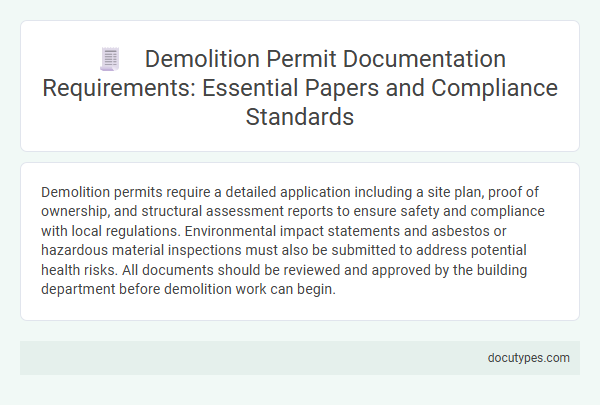Demolition permits require a detailed application including a site plan, proof of ownership, and structural assessment reports to ensure safety and compliance with local regulations. Environmental impact statements and asbestos or hazardous material inspections must also be submitted to address potential health risks. All documents should be reviewed and approved by the building department before demolition work can begin.
Overview of Demolition Permit Documentation
Demolition permits require specific documentation to ensure safety and compliance with local regulations. These documents help authorities assess the project's impact and verify that proper procedures will be followed.
Key documents generally include an application form, site plans, and proof of ownership or authorization. Environmental assessments may be necessary to address hazardous materials like asbestos. Additionally, contractors often need to provide certification of insurance and a detailed demolition plan outlining safety measures.
Key Regulatory Compliance Standards
What are the documentation requirements for demolition permits? You must submit detailed plans showing the scope of the demolition, including structural assessments and environmental impact reports. Compliance with local building codes, OSHA standards, and asbestos abatement regulations is essential for permit approval.
Essential Application Forms and Templates
Demolition permits require specific documentation to ensure compliance with local regulations and safety standards. Understanding the essential application forms and templates helps you prepare an accurate and complete submission.
- Demolition Permit Application Form - This form collects vital project details such as property location, scope of demolition, and contractor information.
- Site Plan Template - A detailed site plan outlines the area to be demolished, neighboring structures, and safety measures.
- Asbestos and Hazardous Material Survey Report - This report confirms the presence or absence of hazardous materials that require special handling during demolition.
Site Assessment and Survey Reports
Demolition permits require thorough documentation to ensure site safety and regulatory compliance. Site assessment and survey reports play a critical role in evaluating the property's condition before demolition.
- Site Assessment Report - Details environmental hazards, structural stability, and potential contaminants on the demolition site.
- Survey Report - Provides precise measurements and layout of the property, identifying boundaries and existing structures.
- Compliance Verification - Confirms that the proposed demolition meets local zoning laws and environmental regulations.
Submitting accurate site assessment and survey reports is essential to obtaining a demolition permit efficiently.
Proof of Property Ownership or Authorization
Proof of property ownership or authorization is a crucial requirement for obtaining a demolition permit. You must provide official documents such as a deed, title, or a legal authorization letter confirming your right to demolish the property. These documents ensure the permit application complies with local regulations and verifies your legal authority over the site.
Environmental Impact Assessments
Demolition permits require thorough documentation to ensure compliance with local regulations. One critical document is the Environmental Impact Assessment (EIA), which evaluates potential effects on air quality, soil, water, and wildlife.
The EIA must detail waste management plans and hazardous material handling, such as asbestos removal. Your submission should include these assessments to prevent environmental harm and expedite permit approval.
Asbestos and Hazardous Material Reports
| Documentation Requirement | Description |
|---|---|
| Asbestos Survey Report | A mandatory inspection report conducted by a certified asbestos inspector to identify and quantify asbestos-containing materials (ACMs) in the demolition area. This report ensures compliance with environmental safety regulations and protects workers and the community from asbestos exposure. |
| Asbestos Abatement Plan | A detailed plan outlining the procedures for safe removal, handling, and disposal of asbestos materials. The plan must comply with local, state, and federal asbestos regulations, including methods for air monitoring and worker protection during demolition. |
| Hazardous Material Inventory | A comprehensive list identifying all hazardous substances present on-site, such as lead-based paint, mercury, PCBs, and other toxic materials. This inventory is required to ensure proper handling and disposal in accordance with environmental protection laws. |
| Hazardous Material Management Plan | This plan details the protocols for safe removal, containment, and disposal of hazardous materials found during the survey. The goal is to minimize environmental impact and health risks during the demolition process. |
| Certification of Report Accuracy | A signed certification by licensed professionals verifying the accuracy and completeness of all submitted asbestos and hazardous material reports. This certification is often required by permitting authorities to validate compliance before granting demolition permits. |
Structural Engineering Evaluations
Documentation for demolition permits often requires a thorough structural engineering evaluation to ensure safety and compliance with local regulations. Your submission must include detailed reports that assess the integrity and hazards of the existing structure before demolition begins.
- Structural Integrity Report - A licensed structural engineer must provide a detailed assessment of the building's framework and load-bearing elements to confirm it is safe to proceed with demolition.
- Hazard Identification - The evaluation must identify potential risks such as asbestos, lead, or unstable structures that could impact demolition safety and environmental health.
- Compliance Verification - The report must demonstrate adherence to local building codes and demolition standards, ensuring all structural risks are mitigated during permit approval.
Utility Disconnection and Safety Certifications
Demolition permits require detailed documentation proving all utility disconnections, including gas, electric, water, and sewer services, to ensure site safety. Safety certifications from licensed professionals must be submitted, confirming compliance with local building codes and hazardous material handling regulations. These documents are critical for permit approval, minimizing risks during demolition and protecting public health.
What Are the Documentation Requirements for Demolition Permits? Infographic

